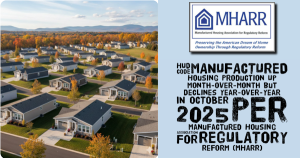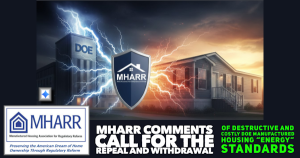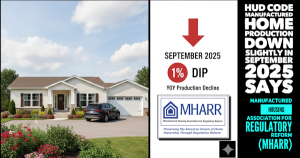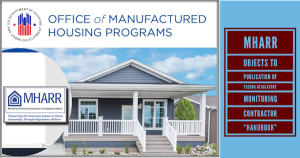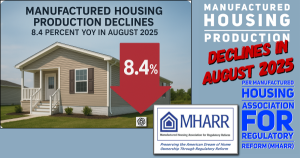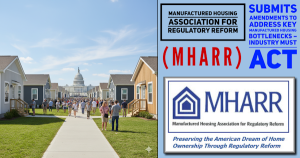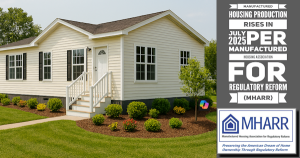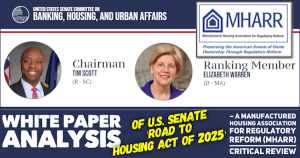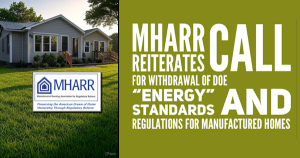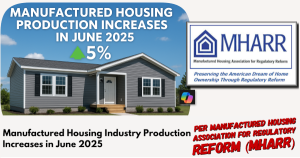Washington, D.C.
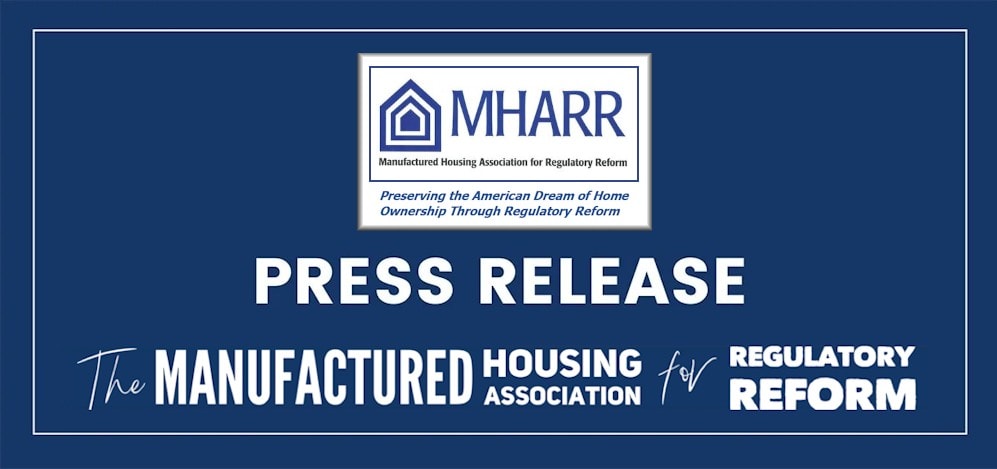
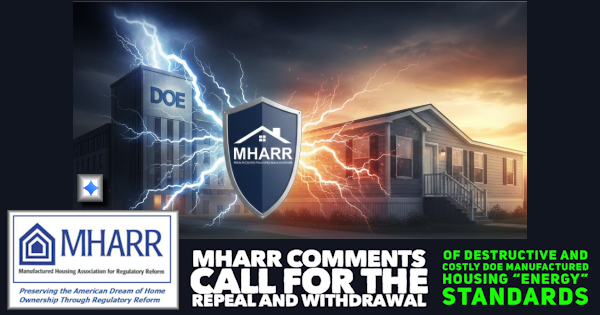
NOVEMBER 24, 2025
IMPORTANT
TO: HUD CODE MANUFACTURED HOUSING INDUSTRY MEMBERS
FROM: MHARR
RE: MHARR COMMENTS CALL FOR THE REPEAL AND WITHDRAWAL OF
DESTRUCTIVE AND COSTLY DOE MANUFACTURED HOUSING “ENERGY” STANDARDS
Attached for your review, information and follow-up is a copy of MHARR’s comments in response to the U.S. Department of Energy’s (DOE) September 3, 2025 Request for Information (RFI) concerning manufactured housing “energy conservation” standards. These comments call on DOE to fully repeal and withdraw the pending costly and destructive DOE manufactured housing energy standards rule, as well as the related December 26, 2023 DOE enforcement procedures proposed rule pertaining to those standards. Simply put, in a nation with an affordable housing shortage measuring in millions of homes, the inherent affordability of manufactured homes should not be needlessly undermined with baseless “climate change” mandates.
As always, MHARR urges all industry members to comment on this matter. Comments in response to the pending RFI are due on or before December 2, 2025. Industry members are free to cite MHARR’s comments in whole or in part, or alternatively to write DOE at the address shown in the MHARR comments (with a specific reference to “Request for Information – Manufactured Housing Energy Conservation Standards – Docket No. EERE-2009-BT-BC-0021”) and state their support for the Manufactured Housing Association for Regulatory Reform’s November 24, 2025 comments.
Thank you.
Attachments
Manufactured Housing Association for Regulatory Reform (MHARR)
1331 Pennsylvania Ave N.W., Suite 512
Washington D.C. 20004
Phone: 202/783-4087
Fax: 202/783-4075
Email: MHARRDG@AOL.COM
Website: www.manufacturedhousingassociation.org
—
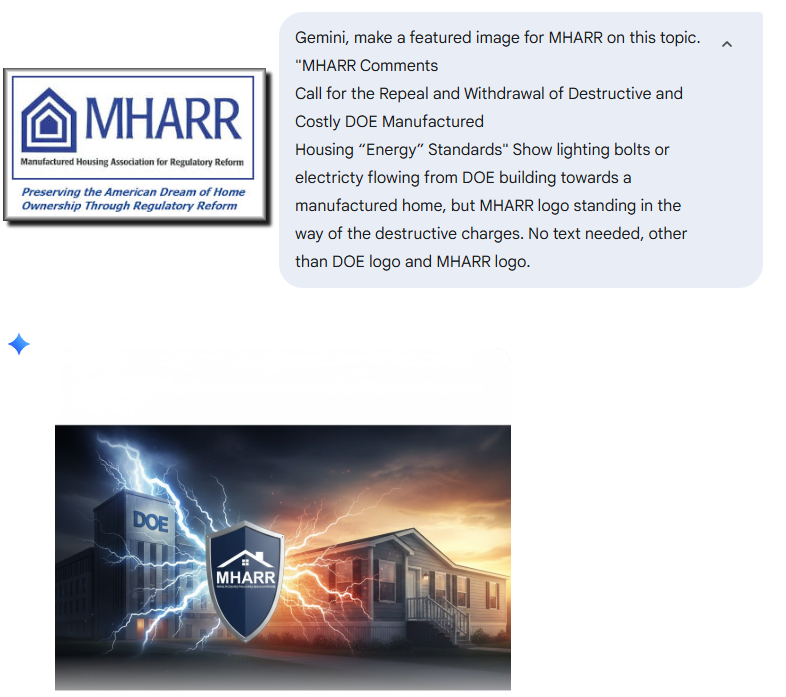
MHARR this report is available for re-publication in full (i.e., without alteration or substantive modification) without further permission and with proper attribution and/or linkback to MHARR.
November 24, 2025
VIA FEDERAL EXPRESS AND ELECTRONIC SUBMISSION
Appliance and Equipment Standards Program
U.S. Department of Energy
Building Technologies Office
Mailstop EE-5B
1000 Independence Avenue, S.W.
Washington, D.C. 20585-0121
Re: Request for Information — Manufactured Housing Energy
Conservation Standards – Docket No. EERE-2009-BT-BC-0021
Dear Sir or Madam:
The following comments are submitted on behalf of the Manufactured Housing Association for Regulatory Reform (MHARR). MHARR is a Washington, D.C.-based national trade association representing the views and interests of producers of manufactured housing regulated by the U.S. Department of Housing and Urban Development (HUD) pursuant to the National Manufactured Housing Construction and Safety Standards Act of 1974 (42 U.S.C. 5401, et seq.) (1974 Act) as amended by the Manufactured Housing Improvement Act of 2000 (2000 Reform Law) and subject to potential energy-related regulation by the U.S. Department of Energy (DOE) pursuant to section 413 of the Energy Independence and Security Act of 2007 (EISA) (42 U.S.C. 17071). MHARR was founded in 1985. Its members include independent manufactured housing producers from all regions of the United States.[1]
I. INTRODUCTION
On September 3, 2025, DOE published a Request for Information (RFI) seeking “public input regarding certain aspects of its energy conservation standards for manufactured housing.”[2] (Emphasis added). DOE initially published a final rule adopting manufactured housing “energy conservation” standards on May 31, 2022,[3] although the enforcement compliance date for those standards has been successively delayed by DOE via regulatory action.[4] DOE subsequently published a proposed rule to establish regulations for testing, compliance and enforcement of those standards on December 26, 2023.[5] No final rule pertaining to the enforcement of the May 31, 2022 manufactured housing energy conservation standards has ever been issued or published by DOE.[6]
As is explained by the September 3, 2025 RFI, the RFI seeks “public input … to help guide DOE’s further refinement of certain aspects of its standards for manufactured housing, as well as supporting technical analysis, including anticipated costs and benefits.”[7] (Emphasis added). The RFI then poses 14 specific issues, questions and inquiries concerning the pending standards on which DOE seeks additional input. Significantly, however, the RFI states that “DOE is also revisiting the 2022 Final Rule in light of [Executive Order] 14192, ‘Unleashing Prosperity Through Deregulation,’ and … seeks stakeholder input on reducing [the] regulatory burden of these regulations.”[8]
On behalf of the smaller, independent, entrepreneurial manufactured housing producers that it represents in Washington, D.C., MHARR, which has strenuously, consistently and inalterably opposed the baseless, destructive “climate change” ideology-driven DOE manufactured housing “energy” standards in both concept and substance since day-one of their fraudulent development and imposition,[9] has only one comment to offer. As is explained in greater detail below, these unnecessary, excessive, extreme and unduly costly standards, in a country with an affordable housing shortage numbering in the millions of units,[10] and in the context of a presidential administration with a stated fundamental commitment to the elimination of needless and destructive regulation,[11] should not be the subject of “fine-tuning,” tinkering around the edges, or “refinement” of any kind. Instead – and in accordance with the fundamental regulatory principles set forth by the President — these standards, including their alleged “enforcement” component, should be jettisoned – withdrawn, repealed and permanently consigned to oblivion in their entirety. In addition, the Administration should fully support and seek the repeal of any conceivable legislative authority underlying this abusive overreach that would needlessly deny Americans the affordable mainstream homeownership that they so desperately need.[12]
II. COMMENTS
The May 31, 2022 DOE manufactured housing “energy conservation” standards must be withdrawn and repealed. The reasons for that conclusion are beyond debate and are factually (and legally) unassailable.
A. The DOE Standards Are Required by Law to be Cost-Justified
First, it is beyond debate that any manufactured housing energy conservation standards adopted by DOE were (and are) affirmatively required by federal law to be cost-justified including, but not limited to, the initial purchase price of the home. Specifically, section 413 of the Energy Independence and Security Act of 2007 – the authorizing legislation for the DOE standards – states, in relevant part:
“The energy conservation standards established under this section shall be based on the most recent version of the International Energy Conservation Code (including supplements), except in cases in which the Secretary finds that the code is not cost-effective, or a more stringent standard would be more cost-effective, based on the impact of the code on the purchase price of manufactured housing and on total life-cycle construction and operating costs.”[13]
(Emphasis added).
An affirmative cost-benefit impact is also mandated by Executive Order 12866, “Regulatory Planning and Review,” (September 30, 1993) which provides, in relevant part:
“Each agency shall assess both the costs and the benefits of the intended regulation and, recognizing that some costs and benefits are difficult to quantify, propose or adopt a regulation only upon a reasoned determination that the benefits of the intended regulation justify its costs.”[14]
Section 413’s statutory mandate, in turn, is specifically enforceable against DOE pursuant to the Administrative Procedure Act (APA), which directs federal courts to “hold unlawful and set aside agency action … found to be arbitrary, capricious and an abuse of discretion, or otherwise not in accordance with law.”[15]
B. The Pending Standards Were Deemed Cost-Justified
by DOE Based on the “Social Cost of Carbon” Metric
Second, it is beyond debate that the May 31, 2022 DOE manufactured housing energy conservation standards published by DOE (with respect to both standard tiers) were affirmatively determined and found by DOE to be cost-justified[16] and “beneficial” based on a purported cost analysis that included substantive and substantial inputs and values derived directly from the Social Cost of Greenhouse Gasses (SCC) metric developed by the federal Interagency Working Group on the Social Cost of Greenhouse Gasses (IWG), including, without limitation, inputs, values and analyses contained in the IWG’s February 2021 “Technical Support Document: Social Cost of Carbon, Methane and Nitrous Oxide.”[17] Accordingly, the May 31, 2022 final rule as published in the Federal Register states:
“DOE estimates the value of climate benefits from a reduction in greenhouse gasses using four different estimates of the social cost of CO2…. Together these represent the social cost of greenhouse gasses (SC-GHG). DOE used interim SC-GHG values developed by an Interagency Working Group on the Social Cost of Greenhouse Gasses….”
The May 31, 2022 notice then specifically cites, as the source of these “values,” the February 2021 IWG Technical Support Document.[18] These so-called “values” are then netted (together with other illusory alleged “benefits”) against the extreme costs of the DOE standards – as demonstrated by MHARR in its previous comments on the DOE standards – to produce a warped and fraudulent alleged net “benefit” for consumers, while totally ignoring the massive individual and collective impacts of the exclusion of millions of Americans from homeownership due to the standards’ extreme impact on the purchase price of manufactured housing (measuring in the thousands of dollars per home — and even more now, due to subsequent inflation — notwithstanding contrary baseless assertions by DOE).
Ultimately, however, the DOE standards were deemed cost-justified and lawful based in substantial (and unavoidable) part on the SCC metric and its related “values.”
C. Any Regulatory Reliance on the SCC Metric and Related
Materials is Affirmatively Prohibited by Executive Order 14154
Third, there is absolutely no current basis for the utilization of – and DOE reliance on – the SCC metric and related materials and/or documents in connection with the cost-benefit evaluation and analysis of the May 31, 2022 DOE standards, and any previous utilization or reliance on such metrics and materials is no longer valid or permissible, insofar as all of those metrics, analyses, studies and so-called support documents, have been eliminated and specifically repudiated as of January 20, 2025, through Executive Order (EO) 14154, “Unleashing American Energy.” In relevant part, that EO states:
“The calculation of the ‘social cost of carbon’ is marked by logical deficiencies, a poor basis in empirical science, politicization, and the absence of a foundation in legislation.”
In accordance with this determination, the EO further states:
“In all federal permitting adjudications or regulatory processes, all agencies shall adhere only to the relevant legislated requirements for environmental considerations and any considerations beyond these requirements are eliminated.”
(Emphasis added). Based on these conclusions, EO 14154, among other things, disbands the IWG and further states:
“any guidance, instruction, recommendation or document issued by the IWG is hereby withdrawn as no longer representative of government policy, including: [(b)(iii)] the Technical Support Document of February 2021 (Social Cost of Carbon, Methane, and Nitrous Oxide Interim Estimates under Executive Order 13990); and [(b)(iv) estimates of the social cost of greenhouse gasses, including the estimates for the social cost of carbon, the social cost of methane and the social cost of nitrous oxide based, in whole or in part, on the IWG’s work or guidance.”
(Emphasis added).
Accordingly, and based upon current law and policy, DOE’s May 31, 2022 final standards’ cost-benefit analysis relies and is based upon invalid, repudiated and withdrawn inputs that have no – and had no – indicia of scientific or policy validity when developed and relied upon by DOE. Therefore, the May 31, 2022 final DOE standards are inherently and irretrievably “arbitrary, capricious and an abuse of discretion” in their total failure to legitimately quantify and consider cost impacts as directed by statute.
As a result, and pursuant to the DOE administrative review referenced by the RFI, the May 31, 2022 final standards should be withdrawn and not merely, modified, amended, or “updated.”
D. DOE has Already Acknowledged that the SCC Metric is Inherently Flawed
The analysis and conclusions set forth above, moreover, are buttressed and supported by DOE’s own research and analysis of the SCC metric. In a July 23, 2025 report, DOE’s Climate Working Group characterized the SCC metric and approach as “flawed,” stating:
“This report supports a more nuanced and evidence-based approach for informing climate policy that explicitly acknowledges uncertainties. The risks and benefits of a climate changing under both natural and human influences must be weighed against the costs, efficacy and collateral impacts of any ‘climate action’ …. An approach that acknowledges both the potential risks and benefits of CO2, rather than relying on flawed models and extreme scenarios, is essential for informed and effective decision-making.”
(Emphasis added).
Up until this point in the DOE manufactured housing energy rulemaking, all that there has been is reliance on “flawed models” and hyper-ventilation over “extreme scenarios.” There is no way to correct this inalterably flawed and corrupted rulemaking on the present regulatory record.
Accordingly, the entire May 31, 2022 final standards rule, the December 26, 2023 proposed enforcement rule, and all components and aspects of each, should be withdrawn, repealed and repudiated. Both of those rules are fundamentally, fatally and irretrievably flawed and cannot be rescued by tinkering around the edges.[19]
III. CONCLUSION
For all of the foregoing reasons, MHARR seeks and supports the repeal and withdrawal of the May 31, 2022 DOE manufactured housing “energy conservation” standards and the proposed December 26, 2023 DOE manufactured housing energy conservation enforcement and compliance regulations. Further, MHARR supports pending congressional consideration and approval of the repeal of section 413 of the Energy Independence and Security Act of 2007. MHARR, therefore, urges DOE and the U.S. Department of Housing and Urban Development to take no further action regarding any such standards or related mandates.
Sincerely,
Mark Weiss
President and CEO
cc: Hon. Donald J. Trump
Hon. Susan Wiles
Hon. Chris Wright
Hon. Tim Scott
Hon. French Hill
Hon. Erin Houchin
Hon. Russell Vought
HUD Code Manufactured Housing Industry Members
[1] MHARR’s members are all “small businesses” as defined by the U.S. Small Business Administration (SBA) and are “small entities” for purposes of the Regulatory Flexibility Act (5 U.S.C. 601, et seq.).
[2] See, 90 Federal Register, No. 168 (September 3, 2025) “Public Input on Energy Conservation Standards for Manufactured Housing” at P. 42544.
[3] See, 87 Federal Register, No. 104 (May 31, 2022) “Energy Conservation Standards for Manufactured Housing” at p. 32728, et seq.
[4] See, 90 Federal Register, supra at pp. 42545-42546 for a summary of DOE regulatory actions regarding the compliance date for the subject standards.
[5] See, 88 Federal Register, No. 246 (December 26, 2023) “Energy Conservation Standards for Manufactured Housing; Enforcement” at p. 88844, et seq.
[6] DOE acknowledges in the RFI that it is “still reviewing” comments on the enforcement Notice of Proposed Rulemaking. See, 90 Federal Register, supra at p. 42546, col. 1.
[7] See, 90 Federal Register, supra at p. 42544, col. 1.
[8] Id. At p. 42545, col. 2-3.
[9] The fraudulent initiation and development of the DOE manufactured housing “energy conservation” standards, through a corrupted “negotiated rulemaking” process, the results and products of which were carried forward through the entire DOE rulemaking in this matter, notwithstanding facile and gratuitous assertions to the contrary by DOE – as well as DOE’s utter failure to substantively consult with HUD and with the statutory Manufactured Housing Consensus Committee, as directed by EISA section 413 — is described in detail by MHARR in its August 8, 2016 comments and attachments in this docket, which MHARR hereby incorporates and included in these comments as if restated in full. These issues are further addressed and detailed in subsequent comments filed by MHARR in this matter, which it also incorporates by reference herein including, without limitation, the following: (1) MHARR’s October 25, 2021 comments and attachments on Energy Conservation Standards for Manufactured Housing; (2) MHARR’s November 22, 2021 comments and attachments on Energy Conservation Standards for Manufactured Housing; (3) MHARR’s May 4, 2022 comments and attachments on Energy Conservation Standards for Manufactured Housing; (4) MHARR’s April 13, 2023 comments and attachments on Energy Conservation Standards for Manufactured Housing; (5) MHARR’s January 24, 2024 comments and attachments on enforcement regulations regarding Energy Conservation Standards for Manufactured Housing; (6) MHARR’s May 31, 2025 comments and attachment on Energy Conservation Standards for Manufactured Housing.
[10] In a March 2025 report, the National Low Income Housing Coalition concluded that the United States faces a national shortage of 7.1 million affordable housing units.
[11] See, e.g., Executive Order 14192, “Unleashing Prosperity Through Deregulation,” January 31, 2025.
[12] See, e.g., H.R. 5184, the “Affordable Housing Over Mandating Energy Efficiency Standards Act of 2025, introduced by Rep. Erin Houchin
[13] See, 42 U.S.C. 17071 (b)(1).
[14] See, Executive Order 12866, “Regulatory Planning and Review” (September 30, 1993, Section 1(b)(6).
[15] See, 5 U.S.C. 706 (2)(A).
[16] See, 87 Federal Register, supra, at p. 32735, col. 1: “DOE has determined that the conservation standards in this final rule are cost-effective when evaluating the impact of the standards on the purchase price of the home and on the total life-cycle and operating costs.”
[17] Id. at p. 32733, col. 1 and footnote 5 therein specifically referencing “Interagency Working Group on Social Cost of Greenhouse Gasses, Technical Support Document: Social Cost of Carbon, Methane and Nitrous Oxide. Interim Estimates under Executive Order 13990.”.
[18] See, 87 Federal Register, supra at p. 32733, n. 5.
[19] An additional independent grounds for withdrawing the May 31, 2022 standards is illustrated by the Executive Order, “Directing the Repeal of Unlawful Regulations” issued on April 6, 2025. That EO directs federal agencies to “identify … unlawful and potentially unlawful regulations … and begin plans to repeal them.” Among other things, the EO directs the repeal of regulations that are (or have become) unlawful under ten recent Supreme Court decisions, including Loper Bright Enterprises v. Raimondo, 603 U.S. 369 (2024). That decision ended the concept of Chevron deference to the interpretation of ambiguous statutes by federal regulatory agencies. MHARR maintains that the May 31, 2022 final rule and final standards violate EISA section 413 insofar as the May 31, 2022 final rule is based upon multiple, compounded, cumulative, baseless “interpretations” of section 413 and its alleged intent by DOE. Those baseless interpretations, as fully explained in prior MHARR comments within the administrative record, include but are not limited to, distortions, manipulation and de facto re-writing of certain aspects of the International Energy Conservation Code (IECC) in a futile effort to conform that Code – which was not developed for manufactured housing – to the unique construction of manufactured housing as mandated by federal law. For this reason as well, the May 31, 2022 standards cannot be salvaged or legitimized under any theory.

